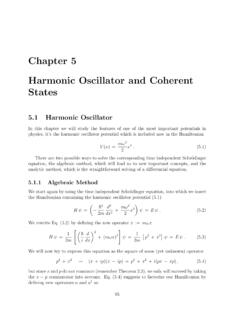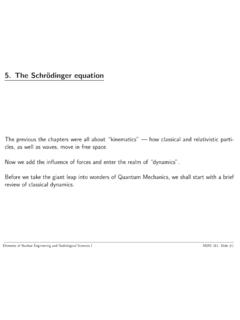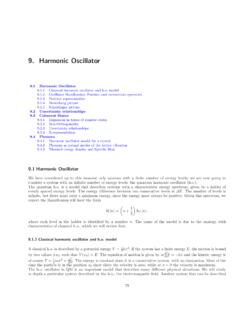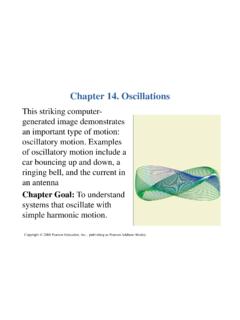Transcription of AN2867 Application note
1 October 2021AN2867 Rev 151/591AN2867 Application noteOscillator design guide for STM8AF/AL/S, STM32 MCUs and MPUs IntroductionMany designers know oscillators based on Pierce-Gate topology (hereinafter referred to as Pierce oscillators ), but not all of them really understand how they operate, and only a few master their design. In practice, limited attention is paid to the oscillator design, until it is found that it does not operate properly (usually when the product where it is embedded is already being produced). A crystal not working as intended results in project delays if not overall oscillator must get the proper amount of attention during the design phase, well before moving to manufacturing, to avoid the nightmare scenario of products being returned from the Application note introduces the Pierce oscillator basics and provides guidelines for the oscillator design. It also shows how to determine the different external components, and provides guidelines for correct PCB design and for selecting suitable crystals and external speed-up the Application development the recommended crystals (HSE and LSE) for the products listed in Table 1 are detailed in Section 5: Recommended resonators for STM32 MCUs/MPUs and Section 6: Recommended crystals for STM8AF/AL/S microcontrollers.
2 Table 1. Applicable productsTypeProduct categoriesMicrocontrollersSTM8S Series, STM8AF Series and STM8AL SeriesSTM32 32-bit Arm Cortex MCUsMicroprocessorsSTM32 Arm Cortex Rev 15 Contents1 Quartz crystal properties and model .. 62 Oscillator theory .. resistance .. oscillator principles .. 103 Pierce oscillator design .. to Pierce oscillators .. resistor .. capacitance .. transconductance .. level and external resistor calculation .. the drive level .. drive level measurement method .. the external resistor .. time .. pullability .. factor .. methodology .. factor for STM32 and STM8 oscillators .. modes .. are fundamental and overtone modes? .. overtone mode: pros and cons .. for crystals interfaced with STM32 products .. 224 Guidelines to select a suitable crystal and external components .. oscillators embedded in STM32 MCUs/MPUs.
3 To select an STM32-compatible crystal .. 265 Recommended resonators for STM32 MCUs/MPUs .. 29AN2867 Rev 153 high-speed resonators .. low-speed resonators .. 296 Recommended crystals for STM8AF/AL/S microcontrollers .. numbers of recommended crystal oscillators .. ceramic resonators .. 447 Tips for improving oscillator stability .. design guidelines .. design examples .. guidelines .. sensitivity to PC13 activity .. 518 Reference documents .. 539 FAQs .. 5410 Conclusion .. 5511 Revision history .. 56 List of tablesAN28674/59AN2867 Rev 15 List of tablesTable products .. 1 Table of equivalent circuit parameters .. 7 Table feedback resistor values for given frequencies .. 12 Table factor (Sf) for STM32 and STM8 oscillators .. 19 Table oscillators embedded into STM32 MCUs/MPUs .. 25 Table oscillators embedded in STM32 MCUs/MPUs .. 29 Table crystal / MEMS resonators for the LSE oscillator in STM32 products.
4 30 Table compatible crystals (not exhaustive list).. 43 Table compatible crystals (not exhaustive list).. 43 Table conditions (for consumer) .. 44 Table conditions (for CAN-BUS) .. 44 Table revision history .. 56AN2867 Rev 155/59AN2867 List of figures5 List of figuresFigure crystal model .. 6 Figure in the frequency domain.. 6 Figure curve of a dipole showing a negative trans-resistance area (in purple) .. 9 Figure diagram of a typical oscillation loop based on a crystal resonator .. 10 Figure oscillator circuitry .. 11 Figure transfer function .. 12 Figure drive measurement with a current probe .. 15 Figure resistance measurement methodology description .. 19 Figure and overtone frequencies of an AT-cut quartz crystal .. 20 Figure crystal theoretical model with third overtone.. 21 Figure implementation for third overtone .. 21 Figure of low-speed crystal resonators .. 23 Figure layout for an oscillator circuit.
5 46 Figure with separated GND plane and guard ring around the oscillator .. 47 Figure plane .. 47 Figure around the oscillator.. 47 Figure design (PCB design guidelines not respected) .. 48 Figure design (following guidelines) .. 49 Figure plane .. 49 Figure layer view.. 49 Figure guidelines not respected .. 50 Figure guidelines respected .. 51 Quartz crystal properties and modelAN28676/59AN2867 Rev 151 Quartz crystal properties and modelA quartz crystal is a piezoelectric device converting electric energy into mechanical energy and vice versa. The transformation occurs at the resonant frequency. The quartz crystal can be modeled as shown in Figure 1. Quartz crystal model C0: represents the shunt capacitance resulting from the capacitor formed by the electrodes Lm (motional inductance): represents the vibrating mass of the crystal Cm (motional capacitance): represents the elasticity of the crystal Rm (motional resistance): represents the circuit lossesThe impedance of the crystal (assuming that Rm is negligible) is given by equationZjw----w2Lm Cm 1 C0Cm+ w2Lm Cm C0 ---------------------------------------- ---------------------------------------- ------- =Figure 2 represents the impedance in the frequency 2.
6 Impedance in the frequency domain(1)MS36117V1QC0 RmCmLmFsFaImpedanceInductive behavior:the quartz oscillatesArea of parallelresonance: FpCapacitive behavior:no oscillationPhase (deg)FrequencyFrequency+90 90ai15834bAN2867 Rev 157/59AN2867 Quartz crystal properties and model58Fs is the series resonant frequency when the impedance Z = 0. Its expression can be deduced from equation (1) as follows:Fs12 LmCm------------------------------=Fa is the anti-resonant frequency when impedance Z tends to infinity. Using equation (1), it is expressed as follows:FaFs1 CmC0---------+=The region delimited by Fs and Fa is usually called the area of parallel resonance (shaded area in Figure 2). In this region, the crystal operates in parallel resonance and behaves as an inductance that adds an additional 180 phase to the loop. Its frequency Fp (or FL: load frequency) has the following expression:FpFs1Cm2C0CL+ ------------------------------+ =According to this equation, the oscillation frequency of the crystal can be tuned by varying the load capacitance CL.
7 This is why, in their datasheets, crystal manufacturers indicate the exact CL required to make the crystal oscillate at the nominal b l e 2 gives an example of equivalent crystal circuit component values to have a nominal frequency of 8 MHz. Using equations (2), (3) and (4) it is possible to determine Fs, Fa and Fp of this crystal: Fs = 7988768 Hz Fa = 8008102 HzIf the load capacitance CL is equal to 10 pF the crystal oscillates at Fp = 7995695 have an oscillation frequency of exactly 8 MHz, CL must be pF.(2)(3)(4)Table 2. Example of equivalent circuit parametersEquivalent componentValueRm8 pFOscillator theoryAN28678/59AN2867 Rev 152 Oscillator theoryOscillators are among the backbone components of modern digital ICs. They can be classified into different sub-families depending on their topology and operating principles. To each oscillator sub-family corresponds a suitable mathematical model that can be used to study the oscillator behavior and theoretically determine its section deals only with harmonic oscillators (relaxation oscillators are not within the scope of this Application note) with a particular focus (see Section 3) on Pierce-oscillator topology.
8 This is because all the oscillators that require external passive components (external resonator, load capacitors, etc.) covered by this document are of the previously mentioned type and harmonic oscillator family can be divided into two main sub-families: negative-resistance oscillators positive-feedback two sub-families of oscillators are similar for what concerns the output waveform. They deliver an oscillating waveform at the desired frequency. This waveform is typically composed of a fundamental sine wave of the desired frequency plus a sum of overtone harmonics (at frequencies multiple of the fundamental one) due to the nonlinearity of some components of the oscillation two sub-families differ in their operating principles. This difference also implies a different mathematical model to describe and analyze each oscillators are generally modeled using the Barkhausen model where an oscillator must fulfill the Barkhausen criterion to maintain a stable oscillation at the desired Barkhausen model is not fully adequate to describe negative-resistance oscillators , the most suitable approach to analyze is to use the negative-resistance model described in [1].
9 STM32 microcontrollers and microprocessors (based on Arm (a) cores) feature low-speed external (LSE) and high-speed external (HSE) oscillators designed following the negative-resistance principle, hence this section focuses on the presentation of this Negative resistanceTheoretically speaking, a negative resistance is a dipole that absorbs heat and converts the energy into an electrical current proportional to the applied voltage but flowing in the opposite direction (exactly the opposite mechanism of an electrical resistance). In the real world such a dipole does not Arm is a registered trademark of Arm Limited (or its subsidiaries) in the US and/or Rev 159/59AN2867 Oscillator theory58 The term negative resistance is actually a misnomer of the negative trans-resistance , defined by the ratio between a given voltage variation ( V) and the induced current variation ( I). Unlike the resistance, always positive, the trans-resistance (also known as differential resistance) can be either positive or negative.
10 Figure 3 gives the current-voltage curve for a dipole that shows a negative trans-resistance region. It is obvious that the V/I ratio is always positive, this is not the case for the V / I portion of the I-V curve in purple shows a negative trans-resistance: V I------- -VD VC ID IC ---------------------------------0<= while the portions in blue feature a positive trans-resistance: V I------- -VB VA IB IA --------------------------------0>=Figure 3. I-V curve of a dipole showing a negative trans-resistance area (in purple) TransconductanceSimilarly to the conductance, defined as the inverse of the resistance, the transconductance is defined as the inverse of the trans-resistance. Transconductance can also be defined as the differential conductance, expressed as I / theoryAN286710/59AN2867 Rev Negative-resistance oscillator principlesAn oscillation loop is made of two branches (see Figure 4): The active branch, composed by the oscillator itself, provides the energy to make the oscillation start and build up until it reaches a stable phase.

















